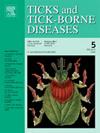法国东部不同生态系统中蜱虫及其人类病原体
IF 3.4
2区 医学
Q2 INFECTIOUS DISEASES
引用次数: 0
摘要
皮蜱是欧洲第二重要的蜱属。它包括两种:分布在更北的网状皮狐和地中海地区典型的边缘皮狐。在法国,特别是在东部,对德玛森托的存在仍未充分研究。利用对蓖麻伊蚊的研究,我们确定了蜱虫的高风险生态系统。两种昆虫均有分布,但网纹夜蛾为优势种(96.3%),常与硬蚊共生,密度达30.3只/100 m2。这个物种被发现在潮湿的草地、冲积森林和湖泊中茁壮成长,在那里野猪(Sus scrofa)很常见。在家畜中,狗和马是首选的主人。关于人类病原体,我们重点关注引起蜱传淋巴结病的立克次体的传播。禽流感风险因地区而异,拉乌尔立克次体是所有省最常见的细菌种类,而斯洛伐克立克次体则较为罕见,仅在2个下莱茵自然保护区存在。在蜱虫活动高峰期,高达18.7%的革螨成年蜱携带拉乌尔氏伊蚊。在研究地区,网纹蝶是这些潜在致病微生物的唯一已知媒介。本文章由计算机程序翻译,如有差异,请以英文原文为准。
Dermacentor ticks and their human pathogens in various ecosystems of eastern France
Dermacentor is Europe’s second most important tick genus. It comprises two species: Dermacentor reticulatus, which has a more northerly range, and Dermacentor marginatus, which is typically found in Mediterranean regions. In France, especially in the east, the presence of Dermacentor remains understudied. Leveraging projects on Ixodes ricinus, we identified high-risk ecosystems for Dermacentor ticks. Both species were present, but D. reticulatus was dominant (96.3 %), always coexisting with Ixodes, at densities reaching 30.3 questing adults/100 m2 in Bas-Rhin. This species was found to thrive in wet meadows, alluvial forests, and lakes, where wild boars (Sus scrofa) are common. Among domestic animals, dogs and horses were the preferred hosts. Regarding human pathogens, we focused on the circulation of rickettsiae responsible for tick-borne lymphadenopathy. Acarological risk varied by region, with Rickettsia raoultii being the most prevalent bacterial species in all the departments, whereas Rickettsia slovaca was rarer and present only in 2 Bas-Rhin nature reserves. At the peak of tick activity, up to 18.7 % of Dermacentor adult ticks carried R. raoultii. In the studied region, D. reticulatus is the only known vector of these potentially pathogenic microorganisms.
求助全文
通过发布文献求助,成功后即可免费获取论文全文。
去求助
来源期刊

Ticks and Tick-borne Diseases
INFECTIOUS DISEASES-MICROBIOLOGY
CiteScore
6.90
自引率
12.50%
发文量
185
审稿时长
6-12 weeks
期刊介绍:
Ticks and Tick-borne Diseases is an international, peer-reviewed scientific journal. It publishes original research papers, short communications, state-of-the-art mini-reviews, letters to the editor, clinical-case studies, announcements of pertinent international meetings, and editorials.
The journal covers a broad spectrum and brings together various disciplines, for example, zoology, microbiology, molecular biology, genetics, mathematical modelling, veterinary and human medicine. Multidisciplinary approaches and the use of conventional and novel methods/methodologies (in the field and in the laboratory) are crucial for deeper understanding of the natural processes and human behaviour/activities that result in human or animal diseases and in economic effects of ticks and tick-borne pathogens. Such understanding is essential for management of tick populations and tick-borne diseases in an effective and environmentally acceptable manner.
 求助内容:
求助内容: 应助结果提醒方式:
应助结果提醒方式:


